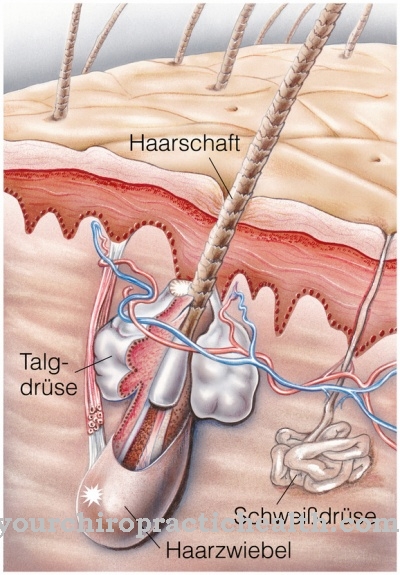Of the Vestibulocochlear nerve is a sensory nerve cord that is composed of the cochlear nerve, the auditory nerve and the vestibular nerve, the equilibrium nerve. The nerve cord is also called 8. Cranial nerve designated. The afferent sensory nerves transmit acoustic and vestibular messages to the corresponding brain nuclei. The auditory nerve in particular also contains efferent fibers that make adjustments to the hearing organ possible via “instructions” from the corresponding brain nuclei.
What is the vestibulocochlear nerve?
In the inner ear, the organs for balance feedback and hearing are practically together because they also form a unit in evolutionary terms. The afferent derivatives of the auditory organ, together with their efferent supply lines, are referred to as the cochlear nerve, because the translation of the received sound waves into nerve impulses takes place in the cochlea.
The afferent sensory fibers of the vestibular organs are called the vestibular nerves. Both nerve cords together form the 8th cranial nerve called the vestibulocochlear nerve. The vestibular nerve is composed of afferent fibers of the individual vestibular organs (3 semicircular canals and 2 otolith organs each). The nerve cords of the auditory nerve and the equilibrium nerve connect to form the vestibulocochlear nerve, which is surrounded by a joint covering of connective tissue and extends into the brain stem.
Shortly before reaching the cranial nerve nucleus or the cochlear and vestibular ganglia, the two nerve cords separate again. The cochlear and vestibular ganglia each consist of several nerve nuclei, including a nucleus of the vestibular apparatus consisting of a collection of Purkinje cells of the cerebellum with a widely branched system of dendrites.
Anatomy & structure
The vestibulocochlear nerve essentially consists of afferent sensory nerve fibers that report nerve impulses from the cochlea and vestibular organs to their ganglia or nuclei. These are axons that are surrounded by a common myelin sheath after the cochlear nerve and the vestibular nerve have joined.
The corresponding cranial nerve nuclei are responsible for the further processing and distribution of the impulses. The vestibular nuclei, for example, ensure that information from the vestibular apparatus is further connected. Efferents move to the thalamus, the cerebellum, the nuclei of the eye muscles and the spinal cord. In this way, the vestibulo-ocular eye reflex can be activated almost without distortion, because the eye muscles are induced to contract directly via the nuclei.
The cochlear nerve, which is part of the vestibulocochlear nerve, combines around 30,000 fibers into one nerve cord, each for the left and right ear. The fibers also consist largely of somatosensory afferent fibers, but also contain efferents. The so-called auditory pathway has a complex branching structure with a number of nerve nuclei in different brain regions and diverges strongly in the brain stem into parallel processing paths.
Function & tasks
The main function of the somatosensory afferent fibers of the vestibulocochlear nerve is to transmit the nerve impulses generated in the cochlea or in the vestibular organs by mechanoreceptors to the corresponding nerve nuclei, which process the signals for the first time.
The signals that come in the opposite direction via the efferent fibers from certain brain regions or from the nuclei are passed on to the vestibular organs or to the hearing organs, where they are implemented. The interconnections of the cochlear as well as the vestibular afferents in different nuclei and brain regions are very complex because the somatosensory impulses are partly information that is made available to various organs "in copy", about certain reflexes such as the vestibulo-ocular reflex without being able to trigger a time delay and because it is a sub-area of multisensory information that is not always compatible with each other, so that in the event of incompatibility the brain has to decide which of the information is "correct" or which is "incorrect".
If visual impressions also play a role at the same time, these are always dominant and incompatible vestibular messages are suppressed. The same applies to cochlear somatosensory impulses. The impulses sent via the afferent fibers of the vestibulocochlear nerve only penetrate our consciousness in a manipulated form after appropriate processing by the responsible brain areas.
You can find your medication here
➔ Medicines for balance disorders and dizzinessDiseases
Symptoms of illness and malfunctions associated with the vestibulocochlear nerve are similar to the symptoms that would result from a malfunction of the cochlea or the organs of equilibrium because somatosensory afferent signals from the organs that are not or incorrectly transmitted have similar effects. Functional disorders of the vestibulocochlear nerve can result from a traumatic brain injury (TBI), a brain tumor or other lesion of the nerve.
Nerve inflammation, in this case vestibulocochlear neuritis, is also the cause of complaints. Such an inflammation of the nerves can be caused by a viral infection or by various kinds of circulatory disorders. The lesions of the vestibulocochlear nerve caused by TBI can manifest themselves in mild to severe balance disorders, dizziness and malaise, as well as impaired hearing and even unilateral deafness. In the case of one-sided imbalance disorders, nystagmus of the eyes can also occur, an unconscious eye movement with a repetition frequency that also occurs with rotational acceleration and stopping a rotational acceleration.
Another symptom can be the loss of the vestibulo-ocular reflex. In this case, there is a high risk of stumbling and falling while walking and running because the eyes are not stabilized and the eyes only follow the much slower voluntary correction. If no organic diseases can be identified in the organs themselves or in the vestibulocochlear nerve, symptoms of dizziness, tinnitus and reduced hearing can be caused by prolonged stress.
























.jpg)



